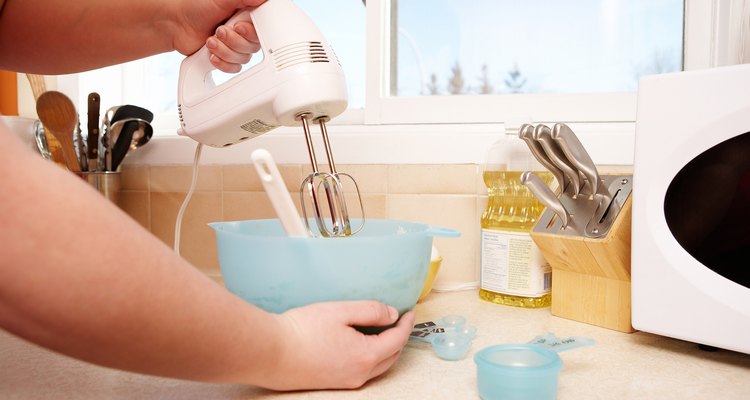
Jupiterimages/Photos.com/Getty Images
Making an amazingly light and tall cheesecake is simpler than you may think, although it does take a little preparation. The basic recipe is easily adapted by switching the crust ingredients or swapping batter ingredients. For example, you can make it tangier by adding sour cream or creamier with heavy cream. No matter what ingredients you choose, this quintessential New York treat is creamy and sweet -- delicious on its own or decadently smothered in fruit or chocolate. Your baking technique is crucial for achieving height and a fluffy texture.
Preparing the Pan
Sticking is the last thing you want when you're releasing your cheesecake from the pan. One of the best ways to prevent a scraggly looking cheesecake is to grease the sides and bottom of the pan and then cut parchment paper into a circle that's big enough to fit into the bottom. Cut tall strips that are long enough to fit the circumference of the pan. Using a pan that’s 5 to 6 inches tall is ideal, but if yours isn’t as tall, overlap two strips of parchment to make your pan higher, allowing you to build a taller cheesecake.
Forming the Crust
A good cheesecake needs a solid base. In a separate bowl, stir graham cracker or cookie crumbs, salt and sugar together. Drizzle melted butter over the mixture and stir until everything is moistened. Put the crust batter into your prepared pan and press and shape it in your pan. Press the dough to make it evenly conformed to the pan without any air bubbles. Bake the crust in an oven that's been heated to 350 degrees Fahrenheit for about 10 minutes. Let the crust cool while you mix the cheesecake filling.
Mixing the Cheesecake
How you prepare the filling is what makes or breaks the height and texture of your cheesecake. Starting with room temperature ingredients -- especially room temperature cream cheese -- is crucial to avoid lumps in your confection. Additionally, beating the cream cheese is particularly important as it makes it fluffy while incorporating plenty of air into the mixture. Another tip is to sift the dry ingredients -- such as flour and baking powder -- to lighten them and aerate them before mixing them evenly into the batter.
Baking the Cheesecake
Wrap foil around the outside of the bottom of the pan to encourage even baking and ensure that water doesn't seep into your cheesecake while it bakes in a water bath. To bake it, place your cheesecake pan inside a larger baking dish and pour enough water into the outer pan to come halfway up the pan. This allows the cheesecake to bake gently and evenly.
Tips and Suggestions
Mixing the batter past the stage where it looks smooth and satiny incorporates too much air into the batter, causing it to inflate like a souffle while it bakes and fall flat once it cools. To avoid this, add the eggs last. Incorporate them one at a time, adding each egg as soon as the yolk from the prior egg breaks. It's also possible to add the yolks and whites separately and beat the egg whites in a separate bowl, along with a little sugar, until it forms stiff peaks. Then fold it into the rest of the batter to give it an even lighter, fluffier, airier texture.
Related Articles
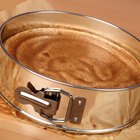
How to Make New York Cheesecake

Gluten-Free Cheesecake Nut Crust

How to Keep Graham Cracker Crusts From ...
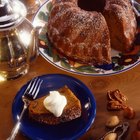
How to Convert a Pan Cake to a Bundt ...

Why Does My Cheesecake Crack?
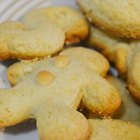
How to Make Butter Sugar Cookies
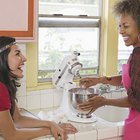
Do You Use a Wire Whip or Flat Beater ...

What Kind of Dish Can I Cook a ...

Brownie Bottom Butterscotch Cheesecake ...

How to Bake Custard in Ramekins
Baking Quiche the Day Before the Party

How to Cook Cheesecake in a Cupcake Pan
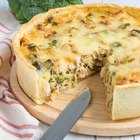
Low-Fat Breakfast Quiche
Why Are My Biscuits Always Flat?

How to Make Bread Chewy

Shortbread Cookie Recipe
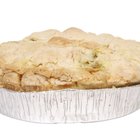
How to Pre-Bake Puff Pastry

What Causes Cheesecakes to Sink in the ...
4 Easy No-Bake Cheesecake Recipes

Wilton Giant Cupcake Pan Instructions
References
- You've Got It Made: Deliciously Easy Meals to Make Now and Bake Later; Diane Phillips
- King Arthur Flour: Brooklyn-Style Cheesecake: The Dairy, Dairy Best
- Serious Eats: Baking With Dorie: Creamy Cream Cheese Cheesecake For Passover--Or Not
- The Kitchn: How to Make Cheesecake That Will Amaze Your Friends
- The Kitchn: Simple Trick: For Smooth and Perfect Cheesecake
- The Kitchn: The Perfect Cheesecake: 5 Tips and Tricks
Writer Bio
Caryn Anderson combines extensive behind-the-scenes writing experience with her passion for all things food, fashion, garden and travel. Bitten by the travel bug at the age of 15 after a trip to Europe, Anderson fostered her love of style and fashion while living in New York City and earning her degree at New York University.
Photo Credits
Jupiterimages/Photos.com/Getty Images